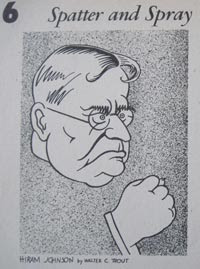 |
| c. 1942-45 |
Inside cover note—
In connection with World War II, scale models of aircraft, many of them made in our schools, have played a vital role. In making these X-ACTO has been in constant demand. If you wish to learn more about this, we'll gladly send you a copy of our booklet, "How to Build Scale Models for Defense," on receipt of 10 cents to cover mailing costs.
Before spotting that reference to the war, I assumed this booklet was about ten years older, as the xacto knife technique illustrations (which may be from an earlier printing) seem heavy on subjects from the 1930s.
Reminiscent of the 1930
Little Caesar, the bursting out of the frame energy in this portrait of Edward G...

...has him duded up, as in
Caesar's "
testimonial" scene.

Soon after the start of the '30s crime movies would be toned down, due to stronger industry enforcement of the
Hollywood Production Code.
And before the decade's end, ambitious actors like Edward G. Robinson and James Cagney were eager to escape "tough guy" typecasting. After both won contracts giving them role and story control, they played law-abiding characters as well as gangsters, and played the later only occasionally, when project quality warranted it. (See for example, discussion in Thomas Schatz,
The Genius of the System, 1988, page 302.)
Of other period notables, there's this—

"Spatter and spray" indeed! This 1937
Life cover story, "
Some Senators Look Like Senators," includes Johnson, called "a thunderous orator, most effective when in opposition."
Wiki also notes—
In 1916 Johnson ran successfully for the U.S. Senate, assuming office on March 16, 1917. It is alleged that was the year that he spoke the words for which he is best remembered today: "The first casualty when war comes is truth," referring to the United States's entry into World War I.
A quote which,
if not a completely new thought, is associated with Johnson in that particular wording.
Other celebrated figures of the era include—

Leopold Stokowski's celebrity began in the 1930s.

Full-page ad, National Geographic, February 1932
Wiki lists the Hollywood features he appeared in: starting with the
The Big Broadcast of 1937, he appeared in others before his greatest success, Disney's
Fantasia (1939).
I have a 1933
National Geographic with a long feature by
Auguste Piccard,
Ballooning in the Stratosphere.
"With 34 Illustrations" and subtitled,
Two Balloon Ascents Presage New Mode of Aërial Travel, the article covers the high-altitude flights and vehicle experimentation that had brought Piccard international fame since the start of the decade. The life and work of the physics professor—plus a face and tall, skinny frame made for caricature—inspired a fellow resident of Brussels to use Piccard as the
basis for a character in Tintin.
Of other "professional work" illustrations, I like the period surrealist-inspired ad art—

"Student work" examples range from grade school to one by a Carnegie Institute of Technology student, whose collage
used wood, paper, scotch tape, sponge rubber, cardboard, cereals, macaroni, etc.
Just about everything but the kitchen sink... "The effect is pleasing," the brochure makes sure to inform us.

Xacto offers this
company history—
X-ACTO was founded in 1917 by Sundel Doniger from New York City. The company started by producing syringes for the medical profession, and in the early 1930's began manufacturing precision surgical blades with a unique handle that accommodated a variety of interchangeable, replaceable scalpels. However, the X-ACTO blade that became the industry standard was created when an X-ACTO advertising artist needed a retouching knife. Doniger created one from his employee's sketch, and it worked so well that the company began manufacturing the product for other artists and hobbyists.
Too bad there are no historical images posted. I'd especially be interested in the dates when the company used this logo—

It's typical of the
"Funny Little Man" design motif of the '20s and '30s. [
Review of Virginia Smith's book.]
Product design history also would be interesting.
Well, I particularly covet the "handy wooden Knife Chest, natural finish $3.50"

 Well, with my boss' negligence causing a pile of backlogged "priority" work to get to me at the last possible moment before the holiday, I know what awaits tomorrow—and the only thing spinning in the cubicle will be my head.
Well, with my boss' negligence causing a pile of backlogged "priority" work to get to me at the last possible moment before the holiday, I know what awaits tomorrow—and the only thing spinning in the cubicle will be my head.
































